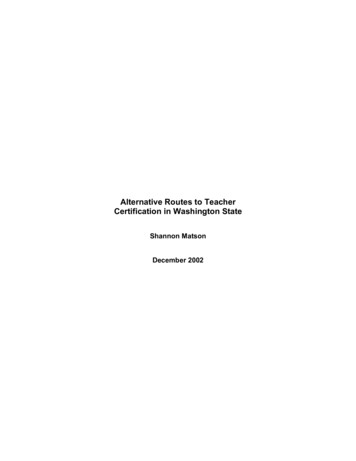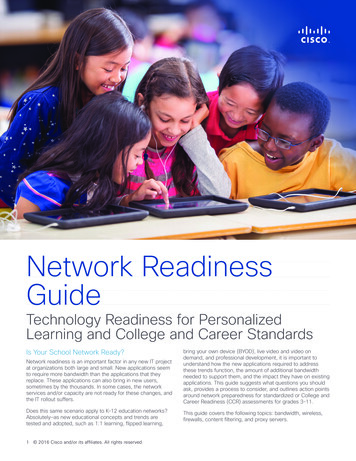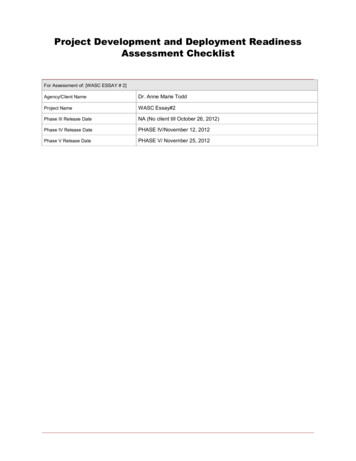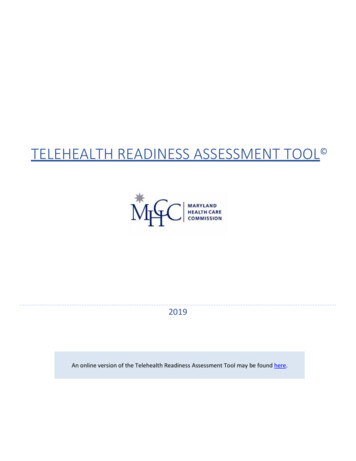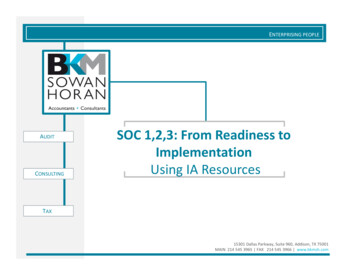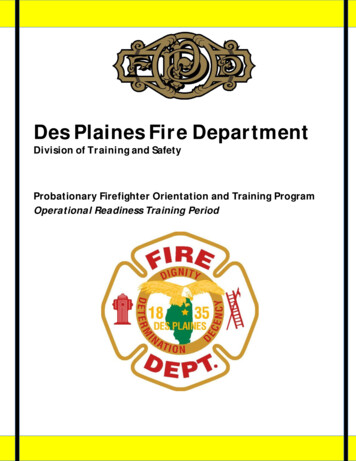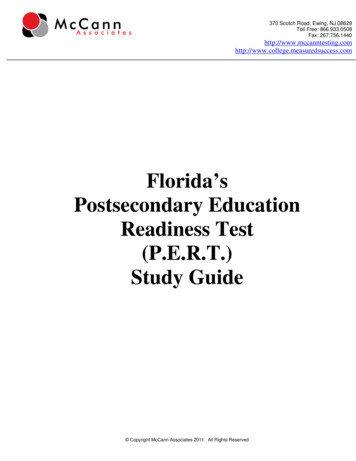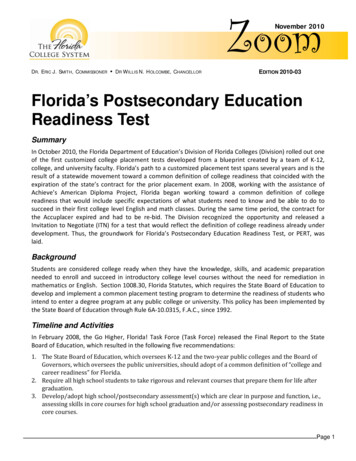
Transcription
Routes to Rural Readiness:Enhancing Clinical Experiences for NursePractitioner Practice in Rural Primary CareLouise Kaplan, PhD, ARNP, FANP-BC, FAANP, FAAN,Washington State UniversitySusan Skillman, MS, University of WashingtonDavis Patterson, PhD, University of Washington
Project TeamWashington State University College of NursingLouise Kaplan, PhD, ARNP, FANP-BC, FAANP, FAAN, Project Co-DirectorUniversity of WashingtonSusan Skillman, MS, Senior Research Scientist and Project DirectorDavis Patterson, PhD, Rural PREP DirectorSamantha Pollack, MHS, Research ScientistAndrew Jopson, MPH, Research ScientistLindsay Pysson, MPA, Program ManagerC. Holly A. Andrilla, MS, StatisticianJP Paredes, Project CoordinatorOhio UniversityRandy Longenecker, MD
Rural PREPThe Collaborative forRuralPrimary care Research, Education, and Practice
Acknowledgment and DisclaimerThis research was supported by the Bureau of Health Workforce(BHW), Health Resources and Services Administration (HRSA), U.S.Department of Health and Human Services (HHS) under cooperativeagreement #UH1HP29966. The information, conclusions andopinions expressed in this presentation are those of the authors andno endorsement by BHW, HRSA, or HHS is intended or should beinferred.
Presentation Objectives Examine characteristics of rural-oriented NP educationprograms Identify factors which promote student participation inrural clinical experiences Describe successful strategies to recruit for and retain NPsin rural practice
Project Objectives Identify approaches of rural-oriented NP education andtraining programs found to be successful in facilitatingNPs’ transition from education to rural employment andeffective practice Identify and describe rural training sites and NPresidencies/fellowships across the U.S. designed to recruitand retain NPs in rural practice
Background Estimates suggest up to 75% of rural primary care servicescould be provided by NPs and physician assistants 2012 National Sample Survey of NPs data indicated ruralcompared with urban NPs more often used their NP skillsto the full extent of their legal scope, were more satisfiedwith their work, and planned to stay in their jobs
Background Factors encouraging NP practice in primary careinclude having NP program faculty mentors,preceptors, and primary care clinical experiences forstudents Little is known about the aspects of rural clinicaltraining that best prepare and encourage NPs tochoose and succeed in rural practice
Project Approach Survey of directors of rural-oriented NP education programs toidentify characteristics of programs most involved in rural areas Interviews with select rural-oriented NP education programdirectors Interviews with directors, preceptors, NPs, and NPresidents/fellows and graduates from rural clinical training sitesØ Topics include motivations for and benefits of participationin rural clinical training, factors that strengthen students’and clinical sites’ training experiences, andrecommendations for support of future training
PreliminarySURVEYRESULTS
Survey Response all# Responses93291913154Total # 9%52.9%*Preliminary results as of 4/30/19
Survey Results* byUS Census RegionMidwest: 58.5%(48/82 programs)South: 48.2%(55/114 programs)Northeast: 43.9%(18/41 programs)West: 62.3%(33/53 programs)*Preliminary results as of 4/30
Rating of Importance of Preparing NPs for RuralPractice to Program’s Mission/Goals*84.9%77.3%NP Program TypeFamily (n 93)69.2%69.0%57.9%Adult-Gerontology (n 29)Pediatrics (n 19)Women's Health (n 13)36.8%27.6%Total Respondents (n 154)30.8%20.1%12.9%5.3%2.2% 3.4%Very ImportantSomewhat Important*Preliminary results as of 4/300.0%Not Important2.6%
Primary Care NP Programs’ Active Recruitment ofRural and Rural-Serving Students*82.4%76.9%71.4%64.3%Family (n 93)Adult-Gerontology (n 29)76.9%72.2%66.7%Pediatrics (n 19)61.5%Women's Health (n 13)Program Actively Recruits Students from Rural AreasProgram Actively Recruits Students Intending to Practice In/Serve Rural*Preliminary results as of 4/3078.7%72.0%Total Respondents(n 154)
Receipt of Dedicated Funding For Rural-OrientedClinical Education in the Past 3 Years*Received Dedicated FundingNoYesn 86n 63Importance of Rural Practice to Program Mission/Goals23.3%15.9%Somewhat Important76.7%84.1%Very ImportantProgram Actively Recruits from Rural Areas27.9%27.0%No72.1%73.0%YesProgram Actively Recruits Students Intending to Practice In/ Serve Rural22.1%20.6%No77.9%79.4%Yes*Preliminary results as of 4/30
NP Programs Currently Offering Rural orRural-serving Primary Care Clinical Sites*NP althTotal# respondentsn 91n 28n 18n 13n 90.0%*Preliminary results as of 4/30
NP Program Ability to Offer Rural/Rural-ServingPrimary Care Clinical Sites*NP ProgramFamily# respondentsConsistently Able to Offer RuralClinical Sites to StudentsOnly Offer Rural Clinical SitesWhen AbleN/A-Not Currently OfferingRural NP otaln 89n 28n 18n 11n .7%5.6%7.1%0.0%9.1%5.5%*Preliminary results as of 4/30
NP Program Barriers to Rural Clinical Training*Major BarrierMinor BarrierNot a BarrierDon't KnowN/A4.3%Competition with other NP education programs for rural clinicaltraining site45.5%32.0%14.3%3.9%5.9%Competition with other (non-NP) health occupations educationprograms for rural clinical training sites42.0%30.4%17.4%4.3%4.4%Student difficulty paying travel and living expenses for rural clinicalrotations32.7%33.5%24.4%5.1%2.0%Few students willing to travel to rural sites28.6%44.2%25.2%1.6%Program does not have sufficient staff to identify/coordinate ruralclinical sites25.6%29.2%2.8%40.8%6.7%Few rural providers willing to precept students20.2%41.1%32.0%1.2%Faculty not able to make site visits to rural areas10.2%*Preliminary results as of 4/3025.4%58.1%5.1%
PRELIMINARYPROGRAM DIRECTORINTERVIEWRESULTS
Characteristics of the Programs§ Most offer all distance or hybrid learning§ Range from 12 students per year to 200 per year§ Locations vary from full practice authority state torestricted practice state§ No specific rural course with rural contentintegrated throughout the curriculum§ Many have HRSA Advanced Nursing EducationWorkforce grants
Characteristics of Students§ Typically in-state students unless program is on astate border§ Some states are mostly rural such as WY and NC sostudents are mostly from rural areas§ Many students seek underserved urban practicerather than rural§ Students who seek rural practice are usually fromrural areas
Characteristics of Successful Rural Sites§ Committed preceptor both to the practice and toteaching/education§ Student is from the rural area and is known to thecommunity§ Patients are willing to see the students
Factors that Facilitate Rural Placements§ Having alumni in the clinical sites§ HRSA funding for students§ Students want to work in the area where the ruralclinic is located§ Personal connections of the faculty
Barriers to Placing Students in Rural Sites§ Competition with other NP programs and otherhealth professions programs§ Student resistance§ Cost of travel§ Shortage of primary care providers§ Clinic policies particularly about productivity§ Health systems limiting NP students
Next Steps Interviews with rural clinical sitesComplete analysis of dataDevelop a set of lessons learned and best practicesDisseminate findings to NP education programs,residencies/fellowships, rural practices, rural healthorganizations and policymakers
References1 BarnesH, Richards MR, McHugh MD, Martsolf G. Rural and nonrural primary care physician practices increasingly rely onnurse practitioners. Health Affairs, 2018: 37(6): 908-914.2 Doescher MP, Andrilla CH, Skillman SM, Morgan P, Kaplan L. The contribution of physicians, physician assistants, andnurse practitioners toward rural primary care: Findings from a 13-state survey. Medical Care, 2014; 52, 549-556.3 Sullivan-Marx EM. Lessons learned from advanced practice nursing payment. Policy, Politics and Nursing Practice, 2008; 9,121-126.4 Spetz J, Skillman SM, Andrilla CH. Nurse practitioner autonomy and satisfaction in rural settings. Medical Care Researchand Review, 2017; 74(2), 227-235.5 Budd GM, Wolf A, Haas RE. Addressing the primary care workforce: a study of nurse practitioner students’ plans aftergraduation. J Nurs Educ. 2015;54(3):130-136.6 Skillman SM, Kaplan L, Andrilla CH, Ostergard S, Patterson DG. Support for rural recruitment and practice among U.S.nurse practitioner education programs. 2014; Policy Brief RC PB147 Skillman.pdf.7 Martsolf GR, PhuongGiang N, Freund D, Poghosyan L. What we know about postgraduate nurse practitioner residencyand fellowship programs. J Nurse Practitioners 2017;13(7):482-487.8 re-rural-health/9 https://www.va.gov/oaa/coepce/np residency.asp
Questions?Louise Kaplan kaplanla@wsu.edu
References 1 Barnes H, Richards MR, McHugh MD, Martsolf G. Rural and nonruralprimary care physician practices increasingly rely on nurse practitioners. Health Affairs, 2018: 37(6): 908-914. 2DoescherMP, Andrilla CH, Skillman SM, Morgan P, Kaplan L.The contribution of physicians, physician assistants, and nurse practitioners to

